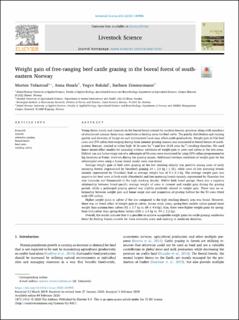| dc.contributor.author | Tofastrud, Morten | |
| dc.contributor.author | Hessle, Anna | |
| dc.contributor.author | Rekdal, Yngve | |
| dc.contributor.author | Zimmermann, Barbara | |
| dc.date.accessioned | 2020-09-14T09:21:27Z | |
| dc.date.available | 2020-09-14T09:21:27Z | |
| dc.date.created | 2020-02-11T18:51:03Z | |
| dc.date.issued | 2020 | |
| dc.identifier.issn | 1871-1413 | |
| dc.identifier.uri | https://hdl.handle.net/11250/2677597 | |
| dc.description.abstract | Young forest stands and clearcuts in the boreal forest created by modern forestry practices along with meadows of abandoned summer farms may contribute as feeding areas for beef cattle. The patchy distribution and varying quality and diversity of forage on such unimproved lands may affect cattle productivity. Weight gain of 336 beef cows and 270 calves free-ranging during three summer grazing seasons was monitored in boreal forests of south-eastern Norway, stocked at either high (0.16 cows ha-1) and low (0.04 cows ha-1) stocking densities. We used linear mixed effect models for assessing intrinsic correlates of weight gain in cows and calves in the two areas. Habitat use and home range size of a subsample of 53 cows were monitored by using GPS collars programmed to log locations at 5 min. intervals during the grazing season. Additional extrinsic correlates of weight gain for the subsampled cows using a linear mixed model were also tested.
Average weight gain of beef cows grazing at the low stocking density was positive among cows of early maturing breeds (represented by Hereford) gaining 24 ± 2.8 kg ( ± SE), while cows of late maturing breeds (mainly represented by Charolais) had an average weight loss of 9 ± 8.4 kg. The average weight gain was negative for beef cows of both early (Herefords) and late maturing breeds (mainly represented by Charolais but also Limousin and Simmental) at the high stocking density. Within both breed groups, there was a negative relationship between breed-specific average weight of cows at turnout and weight gain during the grazing period, while a prolonged grazing period was slightly positively related to weight gain. There was no re-lationship between weight gain and home range size and proportion of grazing habitat for the 53 cows fitted with GPS collars.
Higher weight gains in calves of the low compared to the high stocking density area was found. However, there was no breed effect of weight gain in calves. Across study areas, spring-born suckler calves gained more weight than autumn-born calves (92 ± 1.7 kg vs. 65 ± 4.4 kg). Also, there were higher weight gains for spring-born bull-calves than spring-born heifers (100 ± 2.4 kg vs. 94 ± 2.2 kg).
Overall, the results indicate that it is possible to achieve acceptable weight gains for cattle grazing coniferous forest by finding breeds suitable for these extensive areas and stocking at moderate densities. | en_US |
| dc.language.iso | eng | en_US |
| dc.rights | Navngivelse 4.0 Internasjonal | * |
| dc.rights.uri | http://creativecommons.org/licenses/by/4.0/deed.no | * |
| dc.subject | growth | en_US |
| dc.subject | extensive grazing | en_US |
| dc.subject | boreal forest | en_US |
| dc.subject | beef cows | en_US |
| dc.subject | suckling calves | en_US |
| dc.title | Weight gain of free-ranging beef cattle grazing in the boreal forest of south-eastern Norway | en_US |
| dc.type | Peer reviewed | en_US |
| dc.type | Journal article | en_US |
| dc.description.version | publishedVersion | en_US |
| dc.subject.nsi | VDP::Landbruks- og Fiskerifag: 900::Landbruksfag: 910 | en_US |
| dc.source.pagenumber | 9 | en_US |
| dc.source.volume | 233 | en_US |
| dc.source.journal | Livestock Science | en_US |
| dc.identifier.doi | 10.1016/j.livsci.2020.103955 | |
| dc.identifier.cristin | 1793221 | |
| cristin.ispublished | true | |
| cristin.fulltext | original | |
| cristin.qualitycode | 1 | |

